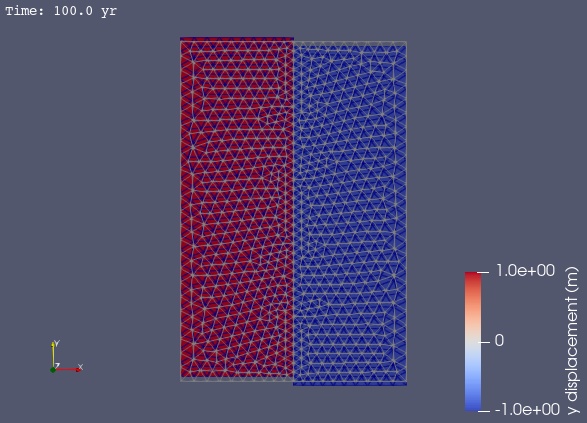Step 2: Single Earthquake Rupture and Velocity Boundary Conditions#
This example involves a quasistatic simulation that solves for the deformation from velocity boundary conditions and prescribed coseismic slip on the fault. We let strain accumulate due to the motion of the boundaries and then release the strain by prescribing 2 meters of right-lateral slip at t=100 years. Fig. 56 shows the boundary conditions on the domain.
Fig. 56 Boundary conditions for quasistatic simulation with velocity boundary conditions and coseismic slip. We set the x displacement to zero on the +x and -x boundaries. We set the y velocity to -1 cm/yr on the +x boundary and +1 cm/yr on the -x boundary. We prescribe 2 meters of right-lateral slip to occur at 100 years to release the accumulated strain energy.#
Features
Triangular cells
pylith.meshio.MeshIOPetsc
pylith.problems.TimeDependent
pylith.materials.Elasticity
pylith.materials.IsotropicLinearElasticity
pylith.faults.FaultCohesiveKin
pylith.faults.KinSrcStep
field split preconditioner
Schur complement preconditioner
pylith.bc.DirichletTimeDependent
spatialdata.spatialdb.UniformDB
pylith.meshio.OutputSolnBoundary
pylith.meshio.DataWriterHDF5
Quasistatic simulation
spatialdata.spatialdb.SimpleDB
Simulation parameters#
The parameters specific to this example are in step02_slip_velbc.cfg.
These include:
pylithapp.metadataMetadata for this simulation. Even when the author and version are the same for all simulations in a directory, we prefer to keep that metadata in each simulation file as a reminder to keep it up-to-date for each simulation.pylithappParameters defining where to write the output.pylithapp.problemParameters defining the start time and end time for the quasistatic simulation.pylithapp.problem.faultParameters for prescribed slip on the fault.pylithapp.problem.bcParameters for velocity boundary conditions.
$ pylith step02_slip_velbc.cfg
# The output should look something like the following.
>> /software/unix/py39-venv/pylith-debug/lib/python3.9/site-packages/pylith/meshio/MeshIOObj.py:44:read
-- meshiopetsc(info)
-- Reading finite-element mesh
>> /src/cig/pylith/libsrc/pylith/meshio/MeshIO.cc:94:void pylith::meshio::MeshIO::read(topology::Mesh *)
-- meshiopetsc(info)
-- Component 'reader': Domain bounding box:
(-50000, 50000)
(-75000, 75000)
# -- many lines omitted --
24 TS dt 0.05 time 1.15
0 SNES Function norm 5.390420823432e-04
Linear solve converged due to CONVERGED_ATOL iterations 29
1 SNES Function norm 1.250412952119e-12
Nonlinear solve converged due to CONVERGED_FNORM_ABS iterations 1
25 TS dt 0.05 time 1.2
>> /software/unix/py39-venv/pylith-debug/lib/python3.9/site-packages/pylith/problems/Problem.py:201:finalize
-- timedependent(info)
-- Finalizing problem.
The beginning of the output written to the terminal is identical to that from Step 1. At the end of the output, we see that the simulation advanced the solution 25 time steps. Remember that the PETSc TS monitor shows the nondimensionalized time and time step values.
Visualizing the results#
In Fig. 57 we use ParaView to visualize the x displacement field using the viz/plot_dispwarp.py Python script.
First, we start ParaView from the examples/strikeslip-2d directory.
$ PATH_TO_PARAVIEW/paraview
# For macOS, it will be something like
$ /Applications/ParaView-5.10.1.app/Contents/MacOS/paraview
Next, we override the default name of the simulation file with the name of the current simulation.
>>> SIM = "step02_slip_velbc"
Finally, we run the viz/plot_dispwarp.py Python script as described in ParaView Python Scripts.
Tip
You can use the “play” button to animate the solution in time.

Fig. 57 Solution for Step 2 at t=100 yr. The colors of the shaded surface indicate the magnitude of the y displacement, and the deformation is exaggerated by a factor of 1000. The undeformed configuration is show by the gray wireframe. The coseismic fault slip at 100 years releases all of the accumulated strain energy.#
